——— X ———
X – the symbol for reactance.
X-copy – an exact copy of an audio or video file. Also called a 1:1.
X curve – an equalization curve used in the film industry that specifies a flat response up to 2 kHz and rolling off at 3 dB per octave above that. For small rooms (less than 150 cubic meters or 5,300 cubic feet) the standard specifies a flat response up to 2 kHz and rolling off at a 1.5 dB per octave above that. Standardized in the late 1970s in ISO 2969, the response is measured at the re-recording position in a dubbing stage or two-thirds of the way back in a movie theater. Also called an extended curve or wide-range curve. See also Academy curve.
Xerox Corporation, Ltd. – an American multinational document management company headquartered in Norwalk, Connecticut, that manufactures and sells printers, photocopiers, digital printing presses, and other related services and supplies.
X-fade – abbreviation for crossfade.
X-fader – abbreviation for crossfader.
xfmr – abbreviation for transformer.
XG – an extension to the general MIDI system developed by Yamaha that provides extra sounds and effects.
XL – see XLR.

XLR – eXtended Locking Round. A type of connector usually having three pins and used with balanced audio connections. While 3-pin versions are most common, 4- and 5-pin configurations are available. In 3-pin versions, pin 1 is the ground (which is usually attached to the shield), pin 2 is hot (+), and pin 3 is cold (-). (This is the current AES standard. Prior to the late 1970s, some manufacturers reversed this with pin 2 cold and pin 3 hot.) Pin 1 is slightly longer than the other two so that the ground is first to make connection, and last to break connection. Because it was developed by James H. Cannon of Cannon Electronics (now ITT), it is sometimes called a cannon connector or cannon plug. A generic version was sometimes called “XL,” because XLR was a trademark belonging to Cannon, but that trademark has expired and the term XLR is now used by all manufacturers.
XMF – eXtensible Music File. A specification developed in 1999 by the MMA for a file format for MIDI data.
XMIDI – Extended MIDI, a proposed upgrade to MIDI with more functions and enhanced features and capabilities.
XMIT – one of several abbreviations for transmit.
XML – eXtensible Markup Language. A free, open-standard for a metalanguage that allows a user to define a customized markup language, to encode documents in a format that is both human-readable and machine-readable to display documents on the internet. XML uses tags similar to those used with HTML, but HTML uses predefined tags while XML uses user-defined tags. HTML has a limited number of tags, but XML tags are unlimited (extensible). HTML tags are used to display, but XML tags are used to describe the data.
XM Satellite Radio, Inc. – a satellite digital radio service (SDARS), headquartered in Washington, D. C., providing pay-for-service radio to the US and Canada, analogous to premium cable television service. Originally Sirius Satellite Radio and XM Radio were competitors, but they merged in 2008 to become Sirius XM, with XM Satellite Radio, Inc. as its subsidiary. They began broadcasting a combined channel lineup a short time later.
XMT – one of several abbreviations for transmit.
XMTR – abbreviation for transmitter.
XOVR – abbreviation for crossover.
X-rays – a form of electromagnetic radiation, similar to light but of shorter wavelength (in the order of 0.1 to 10 nm) that is capable of penetrating solids. Also written as x-rays, X rays, or x rays.
XSTR – abbreviation for transistor.
XT – abbreviation for crosstalk.
X-track – the parts of a movie soundtrack that are separated onto its own track on a DAW or other recording unit because it will be replaced by ADR.
x.x – shorthand for surround sound designations, such as 5.1 or 7.1. Somettimes spelled out as x dot x.
X/Y function – see Lissajous figure. Sometimes written X-Y function.

xylophone – a percussion musical instrument consisting of row of wooden bars of various lengths, over short resonators that go down about half the height of the instrument, played with two small plastic or rubber mallets, called hammers. It is similar to the marimba, which has longer resonators, and the vibraphone, which has metal bars and resonators with rotating discs that produce vibrato. The name come from Greek words xylon (wood) + phone (sound).
X-Y pair – a stereo microphone technique in which two cardioid microphones at the same point are angled at 90 to 120 degrees from one another. It falls into the coincident pair category of microphone methods. Sometime written as XY or X/Y. Other coincident pair techniques include Blumlein array and mid-side. See also near-coincident pair (A-B, DIN, EBS, Faulkner array, NOS, ORTF, RAI) and spaced pair (A-B, Decca tree, spaced cardioids, spaced omnis). See table comparing various stereo microphone techniques.
XYZ controller – a touch pad that transmits signals based on finger position along the horizontal axis (X), the vertical axis (Y), and finger pressure (Z).
Note: We believe this is the largest dictionary (glossary) of terms specific to usage within the recording industry that is currently available on the internet, with more than 8,800 entries, nearly 800 illustrations, and dozens of tables. Some of the terms have different or additional meanings in other situations, especially within the electronic, automotive, scientific, and computer industries. Of necessity there are obvious overlaps into other fields such as music, electronics, and computers, but such excursions are limited to information deemed pertinent to the knowledge required to operate and/or participate effectively in the workings of a recording studio. Also included are terms related to sound reinforcement (live performances) including wireless microphone technology because a working knowledge of that terminology is necessary for recording at live performance venues. Because recording studios also record audio for video and motion pictures (films), some terminology from those fields is included. Some scientific terms are included because they help explain studio terminology. For example, electromagnetism explains how microphones, loudspeakers, and guitar pickups work. Knowledge of radio waves and the radio frequency spectrum is needed to explain wireless devices. Any trademarks or trade names mentioned belong to their respective owners. The information contained in this dictionary is believed to be accurate at the time of publication. This information is subject to change without notice. The information was obtained from and cross-checked with a variety of sources that are believed to be reliable. However, Los Senderos Studio, LLC does not guarantee the accuracy or completeness of the information contained herein. Please contact us to report any errors, omissions, discrepancies, or broken links. Los Senderos Studio shall not be responsible for any consequences or damages arising out of the use of this information. Nothing in this glossary should be interpreted as legal advice. For a glossary providing information on legal and business matters for musicians, we suggest you consult Musicians Business Dictionary.
A note on alphabetical order: The terms in this glossary are alphabetical without regard to spaces and punctuation. For example, AM Radio follows amplitude. While this may seem to be at odds with other conventions, it eliminates confusion with words such as pickup, which is sometimes written as pick up or pick-up. In addition, all symbols such as &, -, or / are ignored. The entries on the number page (0-9) are listed in increasing value within each digit. For example, all of the entries beginning with 1 are listed before those starting with 2. For Greek letters (α-ω), the entries are in Greek alphabetical order.


